Addressing the Value Management Approach in Public Construction Works: Barriers, Critical Success Factors, and Potential Risks
Abstract
1. Introduction
- -
- TS EN 12973 “Value Management”, which has been in effect since its acceptance on 9 November 2020, replacing the previously canceled standard from 11 November 2002 [14].
- -
- TS EN 1325 “Value Management—Dictionary—Terms and Definitions”, currently effective since 29 April 2014, superseding the standards canceled on 11 December 2002 and 2 December 2004 [15].
- -
- TS EN 16271 “Value Management—Functionality of the Required Expression and Functionality of the Performance Attribute—Requirements for Validation and Expression of the Need for the Provision of a Product and Fulfillment of the Purchase Process”, which is valid with a confirmation date of 12 June 2013 [16].
2. Materials and Methods
3. Results
4. Discussion
5. Conclusions
Author Contributions
Funding
Institutional Review Board Statement
Informed Consent Statement
Data Availability Statement
Conflicts of Interest
References
- RICS (The Royal Institution of Chartered Surveyors). Value management and value engineering. Available online: https://www.rics.org/globalassets/rics-website/media/upholding-professional-standards/sector-standards/construction/black-book/value-management-and-value-engineering-1st-edition-rics.pdf (accessed on 2 December 2024).
- Thneibat, M.M.; Basiem, A.-S. Critical success factors for value management techniques in construction projects: Case in Jordan. Int. J. Constr. Manag. 2021, 23, 669–678. [Google Scholar] [CrossRef]
- VM Guide; A Guide to the Value Methodology Body of Knowledge. SAVE International; The Value Society: Northbrook, IL, USA, 2007; p. 12. [Google Scholar]
- FHWA (U.S. Department of Transportation-Federal Highway Administration). Available online: https://www.fhwa.dot.gov (accessed on 3 December 2024).
- GSA (U.S. General Services Administration). Available online: https://www.gsa.gov/real-estate/design-and-construction/engineering/value-engineering (accessed on 3 December 2024).
- Gazzetta Ufficiale. Available online: https://www.gazzettaufficiale.it/atto/serie_generale/caricaDettaglioAtto/originario?atto.dataPubblicazioneGazzetta=2010-12-10&atto.codiceRedazionale=010G0226&elenco30giorni=false (accessed on 2 December 2024).
- Gesetze im Internet. Available online: https://www.gesetze-im-internet.de/vgv_2016/__59.html (accessed on 4 December 2024).
- Magyar Értékelemzők Társasága. Available online: https://shva.hu/altalanos-informaciok/ (accessed on 3 December 2024).
- Yu, A.T.W.; Javed, A.A.; Lam, T.I.; Shen, G.Q.; Sun, M. Integrating value management into sustainable construction projects in Hong Kong. Eng. Constr. Archit. Manag. 2018, 25, 1475–1500. [Google Scholar] [CrossRef]
- Othman, I.; Kineber, A.F.; Oke, A.E.; Zayed, T.; Buniya, M.K. Barriers of value management implementation for building projects in Egyptian construction industry. Ain Shams Eng. J. 2021, 12, 21–30. [Google Scholar] [CrossRef]
- Tanko, B.L.; Abdullah, F.; Mohamad Ramly, Z.; Enegbuma, W.I. An implementation framework of value management in the Nigerian construction industry. Built Environ. Proj. Asset Manag. 2018, 8, 305–319. [Google Scholar] [CrossRef]
- Kim, S.-Y.; Lee, Y.-S.; Nguyen, V.T.; Luu, V.T. Barriers to applying value management in the Vietnamese construction industry. J. Constr. Dev. Ctries. 2016, 21, 55. [Google Scholar] [CrossRef]
- Alshehri, A. Value Management Practices in Construction Industry: An Analytical Review. Open Civ. Eng. J. 2020, 14, 10–19. [Google Scholar] [CrossRef]
- TS EN 12973; Value Management. Turkish Standards Institution (TSE): Ankara, Turkiye, 9 November 2020.
- TS EN 1325; Value Management—Dictionary—Terms and Definitions. Turkish Standards Institution (TSE): Ankara, Turkiye, 29 April 2014.
- TS EN 16271; Value Management—Functionality of the Required Expression and Functionality of the Performance Attribute—Requirements for Validation and Expression of the Need for the Provision of a Product and Fulfillment of the Purchase Process. Turkish Standards Institution (TSE): Ankara, Turkiye, 12 June 2013.
- Nejatyan, E.; Sarvari, H.; Hosseini, S.A.; Javanshir, H. Determining the Factors Influencing Construction Project Management Performance Improvement through Earned Value-Based Value Engineering Strategy: A Delphi-Based Survey. Buildings 2023, 13, 1964. [Google Scholar] [CrossRef]
- Alhumaid, A.M.; Bin Mahmoud, A.A.; Almohsen, A.S. Value Engineering Adoption’s Barriers and Solutions: The Case of Saudi Arabia’s Construction Industry. Buildings 2024, 14, 1017. [Google Scholar] [CrossRef]
- Fong, P.S.-W.; Shen, Q. Is the Hong Kong construction industry ready for value management? Int. J. Proj. Manag. 2000, 18, 317–326. [Google Scholar] [CrossRef]
- Jaapar, A.; Endut, I.R.; Bari, N.A.A.; Takim, R. The impact of value management implementation in Malaysia. J. Sustain. Dev. 2009, 2, 210–219. [Google Scholar] [CrossRef]
- Li, X.; Ma, W. Appraisal of value engineering application to the construction industry in China. In Future Wireless Networks and Information Systems; Springer: Berlin/Heidelberg, Germany, 2012; pp. 303–311. [Google Scholar]
- Sewdayal, S.; Pellissier, R. Developing A Value Engineering Model for A State-Owned Enterprise. S. Afr. J. Ind. Eng. 2024, 35, 20–30. [Google Scholar] [CrossRef]
- Abdelrahman, S.A.; Nassar, A.H. Integrating theory and practice in value engineering within Egypt’s construction industry. J. Eng. Appl. Sci. 2024, 71, 188. [Google Scholar] [CrossRef]
- Khan, A.M.; Alaloul, W.S.; Musarat, M.A. A critical review of digital value engineering in building design towards automated construction. Environ. Dev. Sustain. 2024, 1–46. [Google Scholar] [CrossRef]
- Rwamuhinda, D. Application of Value Management in Conception of Construction Projects in Rwanda: Professionals’ Awareness of and Barriers to Value Management in Construction Projects. Master’s Thesis, School of Architecture and Building Sciences (SABS), JKUAT-SABS, Juja, Kenya, 2024. Available online: http://ir.jkuat.ac.ke/handle/123456789/6467?show=full. (accessed on 25 December 2024).
- Kineber, A.F.; Ali, A.H.; Elshaboury, N.; Oke, A.E.; Arashpour, M. A multi-criteria evaluation and stationary analysis of value management implementation barriers for sustainable residential building projects. Int. J. Constr. Manag. 2024, 24, 199–212. [Google Scholar] [CrossRef]
- Mpofu, S. Impediments to the implementation of value management technique in the public sector projects in Eastern Cape. Master’s Thesis, Faculty of Engineering and the Built Environment Department of Construction Economics and Management, University of Cape Town, Cape Town, South Africa, 2024. [Google Scholar]
- Hussein, A.H.; Saleh, M.Y.; Gabr, S.E.S.; Wefki, H. Integrated Factors Affecting Sustainability and Value Engineering for Egyptian Road Maintenance Projects. Port-Said Eng. Res. J. 2024, 28, 81–92. [Google Scholar] [CrossRef]
- Akinola, G.A.; Fagbenle, O.I.; Ogunde, A.O. Exploring stakeholders’ perspectives on the barriers to the application of cost-reduction techniques in public higher educational building delivery. Buildings 2024, 14, 2551. [Google Scholar] [CrossRef]
- Lin, X.; Mazlan, A.N.; Ismail, S. Barriers to the implementation of value management in small construction projects. J. Build. Eng. 2022, 54, 104639. [Google Scholar] [CrossRef]
- Hwang, B.G.; Zhao, X.; Ong, S.Y. Value management in Singaporean building projects: Implementation status, critical success factors, and risk factors. J. Manag. Eng. 2015, 31, 04014094. [Google Scholar] [CrossRef]
- Li, X.; Deng, B.; Yin, Y.; Jia, Y. Critical obstacles in the implementation of value management of construction projects. Buildings 2022, 12, 680. [Google Scholar] [CrossRef]
- Alattyih, W.; Haider, H.; Boussabaine, H. Risk factors impacting the project value created by green buildings in Saudi Arabia. Appl. Sci. 2020, 10, 7388. [Google Scholar] [CrossRef]
- Kineber, A.F.; Othman, I.; Oke, A.E.; Chileshe, N.; Zayed, T. Modeling the relationship between value management implementation phases, critical success factors and overall project success. Constr. Innov. 2024, 24, 1380–1400. [Google Scholar] [CrossRef]
- Bioku, O.J.; Ataguba, J.O. The Deployment of Value Workshop Objectives to evaluate Value Engineering Awareness and Proficiency among Construction and Allied Professionals. Int. J. Built Environ. Sustain. 2025, 12, 87–99. [Google Scholar] [CrossRef]
- Alragabah, Y.A.; Ahmed, M. Impact assessment of critical success factors (CSFs) in public construction projects of Saudi Arabia. Front. Eng. Built Environ. 2024, 4, 184–195. [Google Scholar] [CrossRef]
- Rostiyanti, S.F.; Nindartin, A.; Kim, J.H. Critical Success Factors Framework of Value Management for Design and Build Infrastructure Projects. J. Des. Built Environ. 2023, 23, 19–34. [Google Scholar] [CrossRef]
- Atabay, S.; Galipogullari, N. Application of Value Engineering in Construction Projects. J. Traffic Transp. Eng. 2013, 1, 39–48. [Google Scholar] [CrossRef][Green Version]
- Sobh, A.; Darwish, S.; Etman, M.; Elfar, A. Using Earned Value Management and Value Engineering tools to enhance system’s productivity, A proposed Framework. Eng. Res. J. 2024, 183, 1–23. [Google Scholar] [CrossRef]
- Yassin, M.S.; Jaapar, A.; Marhani, M.A. Enhancing Projects’ Sustainability Through Value Management Approach for The Malaysian Construction Industry: A Literature Review. In IOP Conference Series: Earth and Environmental Science; IOP Publishing: Bristol, UK, 2022; Volume 1067, p. 012046. [Google Scholar]
- Oke, A.E.; Stephen, S.S.; Aigbavboa, C.O. Value Management Implementation in Construction; Emerald Publishing: Leeds, UK, 2022; Available online: https://www.emerald.com/insight/publication/doi/10.1108/9781802624076 (accessed on 11 December 2024).
- TS. Available online: https://intweb.tse.org.tr/Standard/Standard/StandardAra.aspx (accessed on 11 December 2024).
- Value for Europe. Available online: https://valueforeurope.com/ (accessed on 11 December 2024).
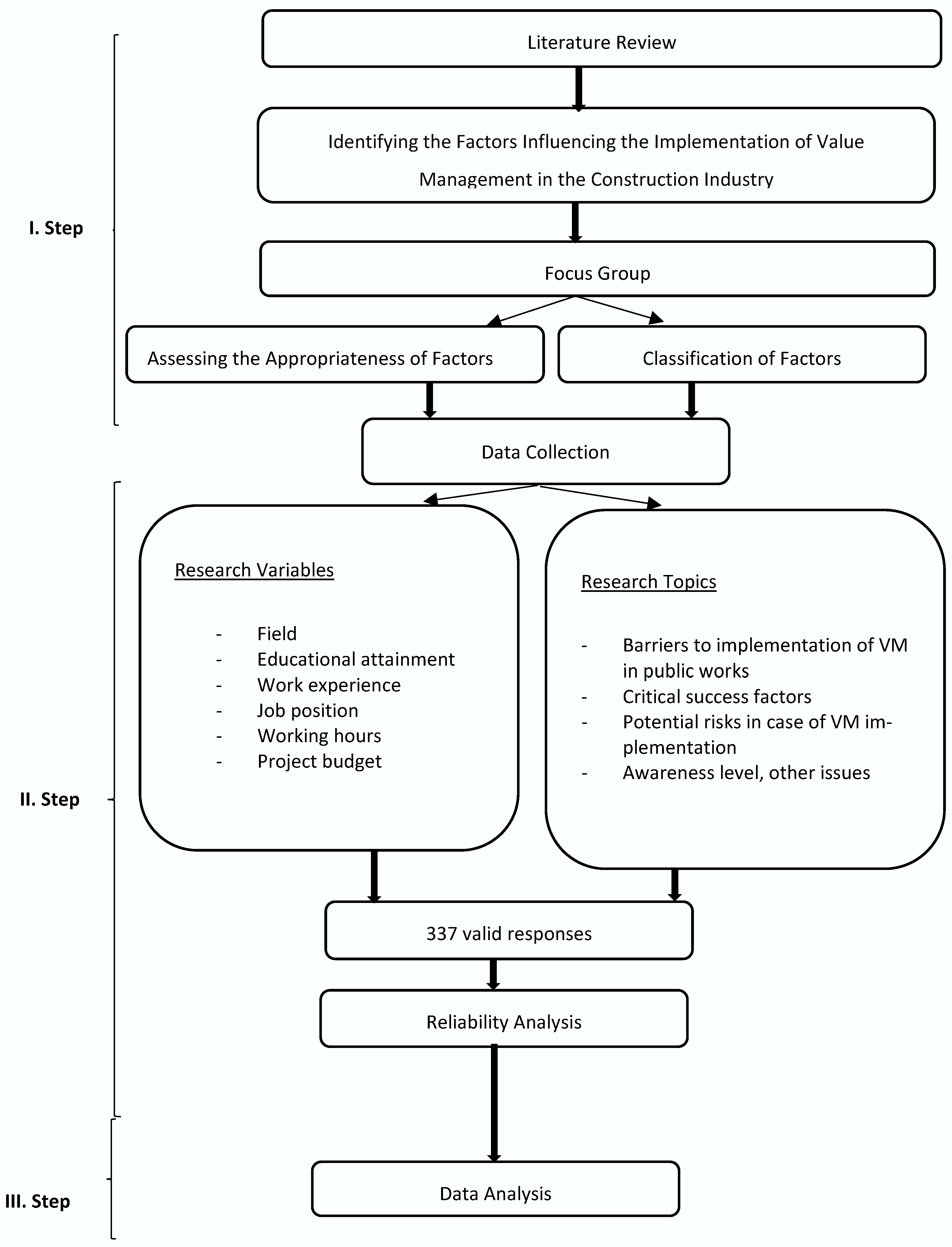

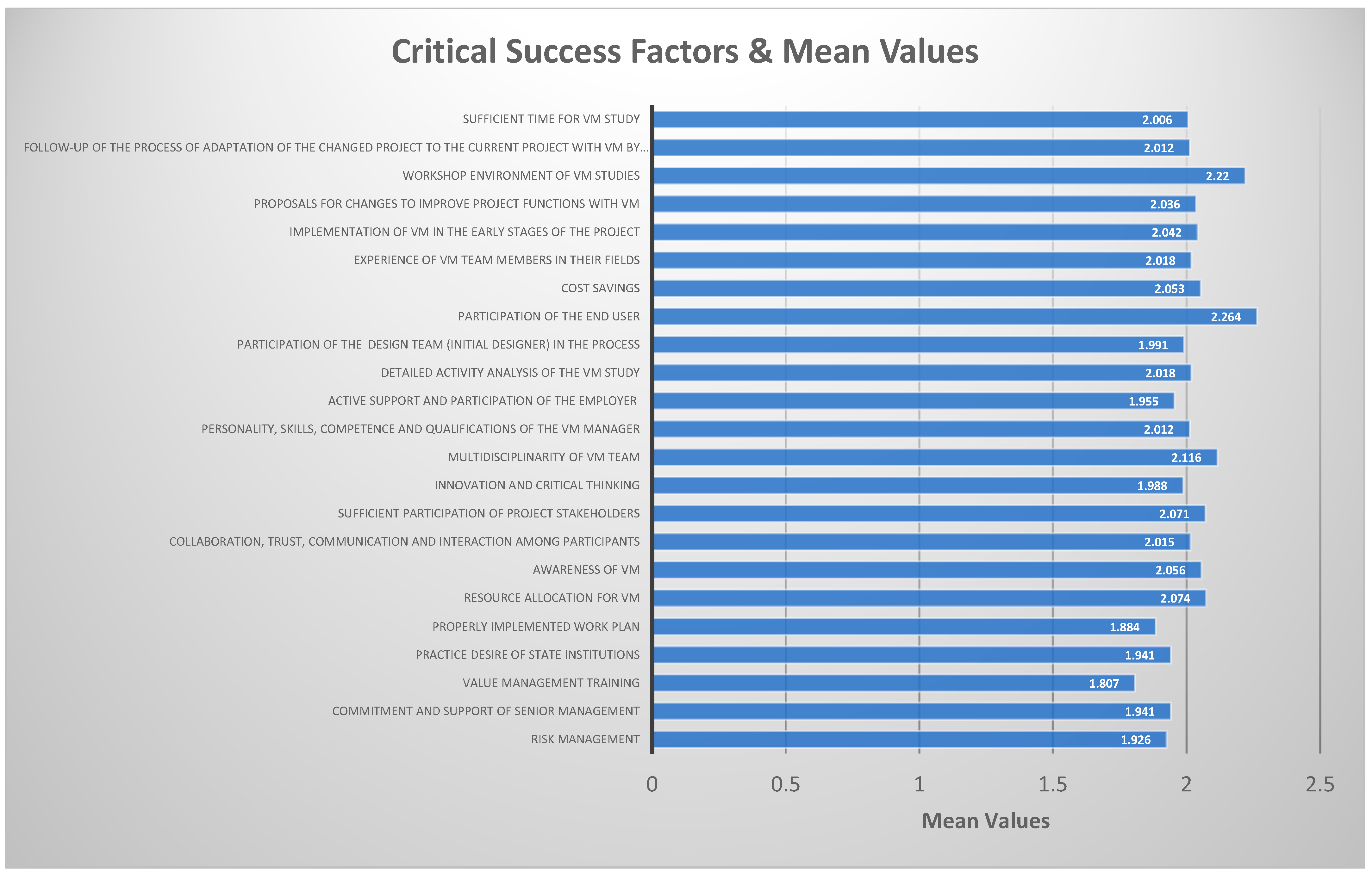
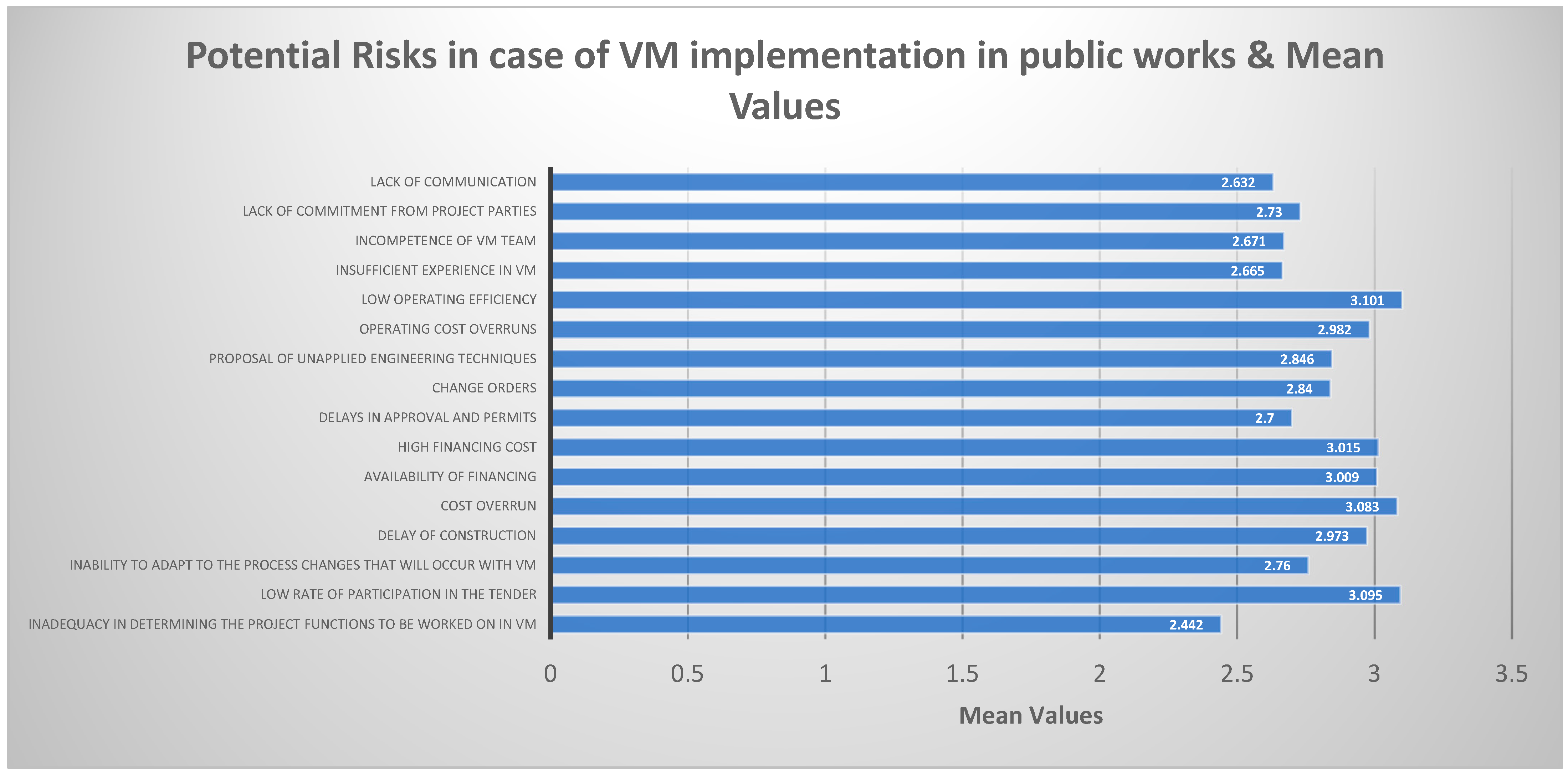
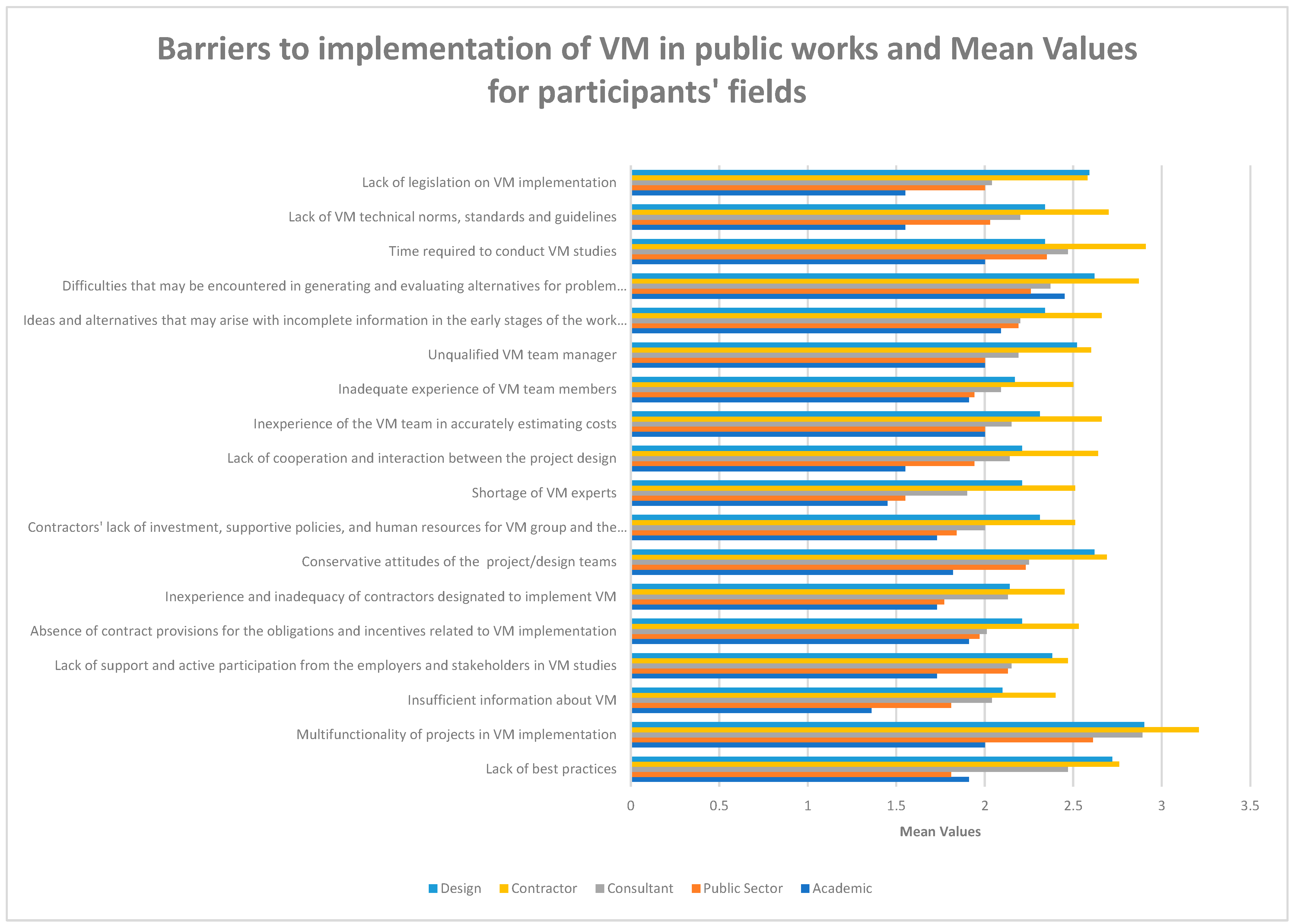
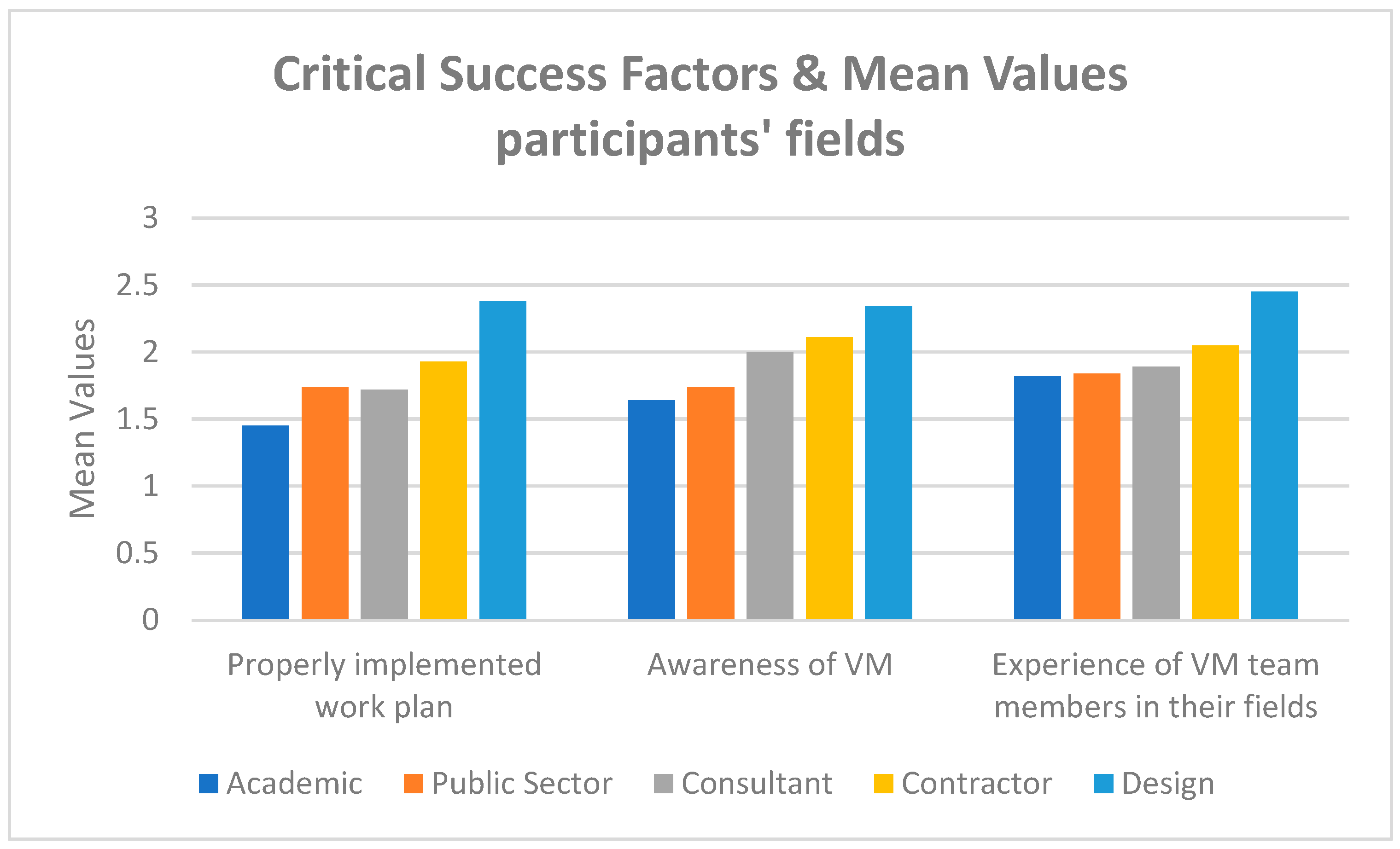
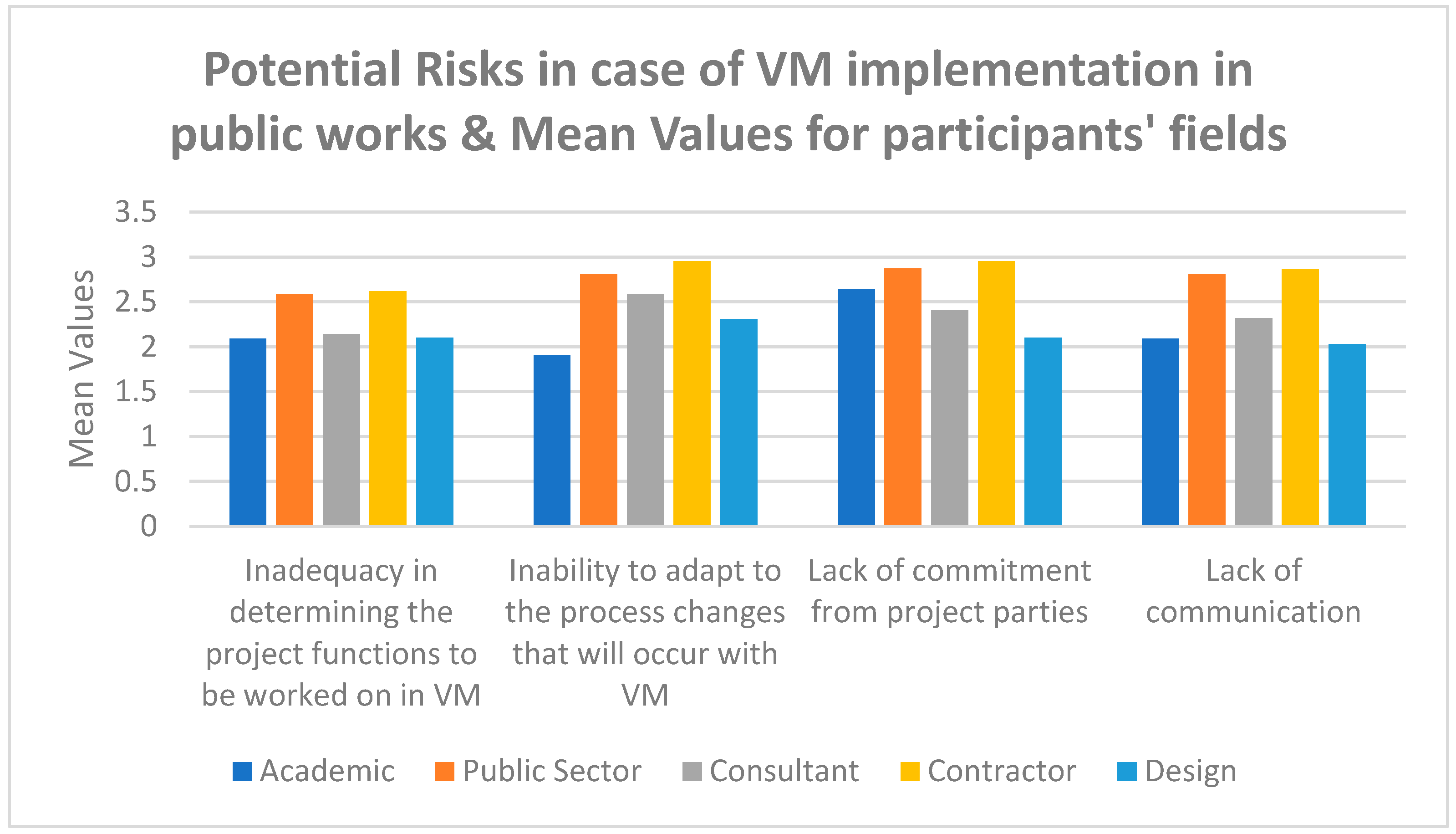
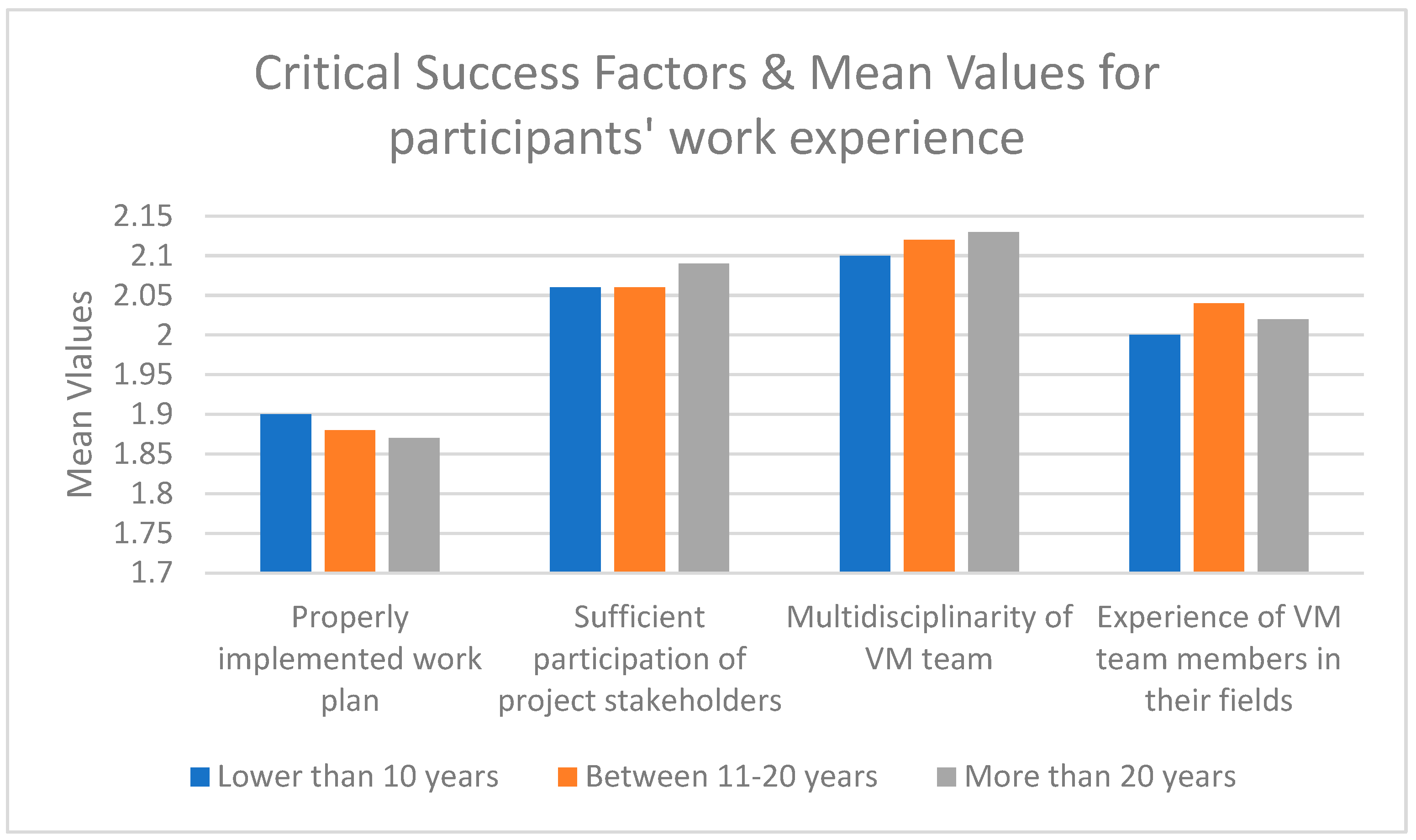
| No | Profession | Field |
|---|---|---|
| 1 | Academic | Civil Enginering |
| 2 | Academic | Civil Enginering |
| 3 | Academic | Civil Enginering |
| 4 | Academic | Civil Enginering |
| 5 | Academic | Actitecture |
| 6 | Expert | Infrastructure Investmenets |
| 7 | Expert | Strategy development |
| 8 | Civil Engineer | Municipality |
| 9 | Project Manager | Consultant |
| 10 | Project Manager | Design |
| 11 | Vice manager | Contractor |
| 12 | Project Manager | Contractor (Infrastructure) |
| 13 | Project Manager | Contractor(Infrastructure) |
| 14 | Project Manager | Contractor (High-rise Buildings) |
| Variables | Categories | n | (%) |
|---|---|---|---|
| Field | Academic | 11 | 3.26 |
| Public Sector | 31 | 9.20 | |
| Consultant | 79 | 23.44 | |
| Contractor | 187 | 55.49 | |
| Design | 29 | 8.61 | |
| Educational Attainment | Associate Degree | 16 | 4.75 |
| Bachelor | 194 | 57.57 | |
| M.Sc. | 52 | 15.43 | |
| PhD | 75 | 22.25 | |
| Work Experience | Lower than 10 years | 179 | 53.12 |
| Between 11–20 years | 45 | 13.35 | |
| More than 20 years | 113 | 33.53 | |
| Job Position | Researcher | 12 | 3.56 |
| Employer (contactor) | 11 | 3.26 | |
| Administrative staff | 62 | 18.40 | |
| Technical staff | 205 | 60.83 | |
| Manager | 47 | 13.95 | |
| Project Budget (VAT excluded) | Lower than 250 Million TL | 18 | 5.34 |
| Between 250 Milllion TL and 500 Milllion TL | 24 | 7.12 | |
| Between 500 Milllion TL and 1.5 Billion TL | 21 | 6.23 | |
| More than 1.5 Billion TL | 254 | 75.37 | |
| None | 20 | 5.9 |
| No | Barriers to Implementation of VM in Public Works | Reference | Mean | Std. Dev. | Rank | p-Values | ||||
|---|---|---|---|---|---|---|---|---|---|---|
| Field | Educational Attainment | Work Experience | Job Position | Project Budget | ||||||
| 1 | Lack of best practices | FG | 2.576 | 1.341 | 4 | 0.001 | p > 0.05 | p > 0.05 | p > 0.05 | p > 0.05 |
| 2 | Multifunctionality of projects in VM implementation | FG | 3.015 | 1.555 | 1 | 0.042 | p > 0.05 | p > 0.05 | p > 0.05 | p > 0.05 |
| 3 | Insufficient information about VM | [21,33] | 2.202 | 1.296 | 18 | 0.000 | p > 0.05 | p > 0.05 | p > 0.05 | p > 0.05 |
| 4 | Lack of support and active participation from the employers and stakeholders in VM studies | [21] | 2.332 | 1.189 | 12 | 0.015 | p > 0.05 | p > 0.05 | p > 0.05 | p > 0.05 |
| 5 | Absence of contract provisions for the obligations and incentives related to VM implementation | [25] | 2.312 | 1.235 | 13 | 0.008 | p > 0.05 | p > 0.05 | p > 0.05 | p > 0.05 |
| 6 | Inexperience and inadequacy of contractors designated to implement VM | FG | 2.264 | 1.251 | 16 | 0.004 | p > 0.05 | p > 0.05 | p > 0.05 | p > 0.05 |
| 7 | Conservative attitudes of the project/design teams | [24] | 2.510 | 1.282 | 5 | 0.001 | p > 0.05 | p > 0.05 | p > 0.05 | p > 0.05 |
| 8 | Contractors’ lack of investment, supportive policies, and human resources for VM | [12] | 2.288 | 1.233 | 15 | 0.000 | p > 0.05 | p > 0.05 | p > 0.05 | p > 0.05 |
| 9 | Shortage of VM experts | [12] | 2.217 | 1.231 | 17 | 0.000 | p > 0.05 | p > 0.05 | p > 0.05 | p > 0.05 |
| 10 | Lack of cooperation and interaction between the project design group and the VM team | [25] | 2.386 | 1.270 | 10 | 0.000 | p > 0.05 | p > 0.05 | p > 0.05 | p > 0.05 |
| 11 | Inexperience of the VM team in accurately estimating costs | FG | 2.430 | 1.278 | 8 | 0.003 | p > 0.05 | p > 0.05 | p > 0.05 | p > 0.05 |
| 12 | Inadequate experience of VM team members | FG | 2.306 | 1.197 | 14 | 0.007 | p > 0.05 | p > 0.05 | p > 0.05 | p > 0.05 |
| 13 | Unqualified VM team manager | FG | 2.421 | 1.367 | 9 | 0.019 | p > 0.05 | p > 0.05 | p > 0.05 | p > 0.05 |
| 14 | Ideas and alternatives that may arise with incomplete information in the early stages of the work plan | FG | 2.466 | 1.229 | 6 | 0.023 | p > 0.05 | p > 0.05 | p > 0.05 | p > 0.05 |
| 15 | Difficulties that may be encountered in generating and evaluating alternatives for problem solving in VM implementation | FG | 2.659 | 1.311 | 3 | 0.018 | p > 0.05 | p > 0.05 | p > 0.05 | p > 0.05 |
| 16 | Time required to conduct VM studies | [12,36] | 2.677 | 1.388 | 2 | 0.003 | p > 0.05 | p > 0.05 | p > 0.05 | p > 0.05 |
| 17 | Lack of VM technical norms, standards, and guidelines | [12,26] | 2.454 | 1.329 | 7 | 0.001 | p > 0.05 | p > 0.05 | p > 0.05 | p > 0.05 |
| 18 | Lack of legislation on VM implementation | FG | 2.368 | 1.319 | 11 | 0.000 | p > 0.05 | p > 0.05 | p > 0.05 | p > 0.05 |
| Critical Success Factors | FG | |||||||||
| 1 | Risk management | FG | 1.926 | 0.950 | 18 | p > 0.05 | p > 0.05 | p > 0.05 | p > 0.05 | p > 0.05 |
| 2 | Commitment and support of senior management | FG | 1.941 | 0.894 | 17 | p > 0.05 | p > 0.05 | p > 0.05 | p > 0.05 | p > 0.05 |
| 3 | Value management training | FG | 1.807 | 0.914 | 20 | p > 0.05 | p > 0.05 | p > 0.05 | p > 0.05 | p > 0.05 |
| 4 | Practice desire of state institutions | FG | 1.941 | 0.998 | 17 | p > 0.05 | p > 0.05 | p > 0.05 | p > 0.05 | p > 0.05 |
| 5 | Properly implemented work plan | FG | 1.884 | 0.904 | 19 | 0.007 | p > 0.05 | 0.046 | p > 0.05 | p > 0.05 |
| 6 | Resource allocation for VM | FG | 2.074 | 0.984 | 4 | p > 0.05 | p > 0.05 | p > 0.05 | p > 0.05 | p > 0.05 |
| 7 | Awareness of VM | [25,27,35] | 2.056 | 0.997 | 6 | 0.040 | p > 0.05 | p > 0.05 | p > 0.05 | p > 0.05 |
| 8 | Collaboration, trust, communication, and interaction among participants | [31] | 2.015 | 0.977 | 11 | p > 0.05 | p > 0.05 | p > 0.05 | p > 0.05 | p > 0.05 |
| 9 | Sufficient participation of project stakeholders | FG | 2.071 | 1.000 | 5 | p > 0.05 | p > 0.05 | 0.027 | p > 0.05 | p > 0.05 |
| 10 | Innovation and critical thinking | FG | 1.988 | 0.939 | 15 | p > 0.05 | p > 0.05 | p > 0.05 | p > 0.05 | p > 0.05 |
| 11 | Multidisciplinarity of VM team | FG | 2.116 | 1.036 | 3 | p > 0.05 | p > 0.05 | 0.036 | p > 0.05 | p > 0.05 |
| 12 | Personality, skills, competence, and qualifications of the VM manager | FG | 2.012 | 1.023 | 12 | p > 0.05 | p > 0.05 | p > 0.05 | p > 0.05 | p > 0.05 |
| 13 | Active support and participation of the employer | FG | 1.955 | 1.024 | 16 | p > 0.05 | p > 0.05 | p > 0.05 | p > 0.05 | p > 0.05 |
| 14 | Detailed activity analysis of the VM study | FG | 2.018 | 0.994 | 10 | p > 0.05 | p > 0.05 | p > 0.05 | p > 0.05 | p > 0.05 |
| 15 | Participation of the design team (initial designer) in the process | FG | 1.991 | 0.934 | 14 | p > 0.05 | p > 0.05 | p > 0.05 | p > 0.05 | p > 0.05 |
| 16 | Participation of the end user | FG | 2.264 | 1.063 | 1 | p > 0.05 | p > 0.05 | p > 0.05 | p > 0.05 | p > 0.05 |
| 17 | Cost savings | [29,36] | 2.053 | 0.977 | 7 | p > 0.05 | p > 0.05 | p > 0.05 | p > 0.05 | p > 0.05 |
| 18 | Experience of VM team members in their fields | FG | 2.018 | 0.913 | 10 | 0.039 | p > 0.05 | 0.042 | p > 0.05 | p > 0.05 |
| 19 | Implementation of VM in the early stages of the project | FG | 2.042 | 0.981 | 8 | p > 0.05 | p > 0.05 | p > 0.05 | p > 0.05 | p > 0.05 |
| 20 | Proposals for changes to improve project functions with VM | FG | 2.036 | 0.975 | 9 | p > 0.05 | p > 0.05 | p > 0.05 | p > 0.05 | p > 0.05 |
| 21 | Workshop environment of VM studies | FG | 2.220 | 1.035 | 2 | p > 0.05 | p > 0.05 | p > 0.05 | p > 0.05 | p > 0.05 |
| 22 | Follow-up of the process of adaptation of the changed project to the current project with VM by the contractor company and support from the public institution | FG | 2.012 | 0.994 | 12 | p > 0.05 | p > 0.05 | p > 0.05 | p > 0.05 | p > 0.05 |
| 23 | Sufficient time for VM study | FG | 2.006 | 0.985 | 13 | p > 0.05 | p > 0.05 | p > 0.05 | p > 0.05 | p > 0.05 |
| Potential Risks in case of VM implementation in public works | ||||||||||
| 1 | Inadequacy in determining the project functions to be worked on in VM | FG | 2.442 | 1.413 | 16 | 0.039 | p > 0.05 | p > 0.05 | p > 0.05 | p > 0.05 |
| 2 | Low rate of participation in the tender | FG | 3.095 | 1.627 | 2 | p > 0.05 | p > 0.05 | p > 0.05 | p > 0.05 | p > 0.05 |
| 3 | Inability to adapt to the process changes that will occur with VM | FG | 2.760 | 1.457 | 10 | 0.003 | p > 0.05 | p > 0.05 | p > 0.05 | p > 0.05 |
| 4 | Delay of construction | FG | 2.973 | 1.548 | 7 | p > 0.05 | p > 0.05 | p > 0.05 | p > 0.05 | p > 0.05 |
| 5 | Cost overrun | [25] | 3.083 | 1.613 | 3 | p > 0.05 | p > 0.05 | p > 0.05 | p > 0.05 | p > 0.05 |
| 6 | Availability of financing | [12] | 3.009 | 1.567 | 5 | p > 0.05 | p > 0.05 | p > 0.05 | p > 0.05 | p > 0.05 |
| 7 | High financing cost | FG | 3.015 | 1.636 | 4 | p > 0.05 | p > 0.05 | p > 0.05 | p > 0.05 | p > 0.05 |
| 8 | Delays in approval and permits | FG | 2.700 | 1.553 | 12 | p > 0.05 | p > 0.05 | p > 0.05 | p > 0.05 | p > 0.05 |
| 9 | Change orders | FG | 2.840 | 1.457 | 9 | p > 0.05 | p > 0.05 | p > 0.05 | p > 0.05 | p > 0.05 |
| 10 | Proposal of unapplied engineering techniques | FG | 2.846 | 1.568 | 8 | p > 0.05 | p > 0.05 | p > 0.05 | p > 0.05 | p > 0.05 |
| 11 | Operating cost overruns | FG | 2.982 | 1.585 | 6 | p > 0.05 | p > 0.05 | p > 0.05 | p > 0.05 | p > 0.05 |
| 12 | Low operating efficiency | FG | 3.101 | 1.608 | 1 | p > 0.05 | p > 0.05 | p > 0.05 | p > 0.05 | p > 0.05 |
| 13 | Insufficient experience in VM | [12,27,31] | 2.665 | 1.513 | 14 | p > 0.05 | p > 0.05 | p > 0.05 | p > 0.05 | p > 0.05 |
| 14 | Incompetence of VM team | [12] | 2.671 | 1.468 | 13 | p > 0.05 | p > 0.05 | p > 0.05 | p > 0.05 | p > 0.05 |
| 15 | Lack of commitment from project parties | [26] | 2.730 | 1.570 | 11 | 0.004 | p > 0.05 | p > 0.05 | p > 0.05 | p > 0.05 |
| 16 | Lack of communication | [25] | 2.632 | 1.545 | 15 | 0.001 | p > 0.05 | p > 0.05 | p > 0.05 | p > 0.05 |
| Significant Relationships where p < 0.05 | ||||||||||
| No | Barriers to Implementation of VM in Public Works | Field | n | Ss | sd | F | p Value | |
|---|---|---|---|---|---|---|---|---|
| 1. | Lack of best practices | Academic | 11 | 1.91 | 1.221 | 4 | 4.558 | 0.001 |
| Public Sector | 31 | 1.81 | 0.910 | |||||
| Consultant | 79 | 2.47 | 1.239 | |||||
| Contractor | 187 | 2.76 | 1.421 | |||||
| Design | 29 | 2.72 | 1.162 | |||||
| 2. | Multifunctionality of projects in VM implementation | Academic | 11 | 2.00 | 1.414 | 4 | 2.684 | 0.042 |
| Public Sector | 31 | 2.61 | 1.647 | |||||
| Consultant | 79 | 2.89 | 1.396 | |||||
| Contractor | 187 | 3.21 | 1.632 | |||||
| Design | 29 | 2.90 | 1.175 | |||||
| 3. | Insufficient information about VM | Academic | 11 | 1.36 | 0.505 | 4 | 3.431 | 0.000 |
| Public Sector | 31 | 1.81 | 1.046 | |||||
| Consultant | 79 | 2.04 | 1.171 | |||||
| Contractor | 187 | 2.40 | 1.405 | |||||
| Design | 29 | 2.10 | 1.081 | |||||
| 4. | Lack of support and active participation from the employers and stakeholders in VM studies | Academic | 11 | 1.73 | 0.647 | 4 | 2.064 | 0.015 |
| Public Sector | 31 | 2.13 | 1.088 | |||||
| Consultant | 79 | 2.15 | 1.026 | |||||
| Contractor | 187 | 2.47 | 1.301 | |||||
| Design | 29 | 2.38 | 0.979 | |||||
| 5. | Absence of contract provisions for the obligations and incentives related to VM implementation | Academic | 11 | 1.91 | 1.136 | 4 | 3.749 | 0.008 |
| Public Sector | 31 | 1.97 | 0.948 | |||||
| Consultant | 79 | 2.01 | 1.068 | |||||
| Contractor | 187 | 2.53 | 1.333 | |||||
| Design | 29 | 2.21 | 1.048 | |||||
| 6. | Inexperience and inadequacy of contractors designated to implement VM | Academic | 11 | 1.73 | 0.905 | 4 | 3.173 | 0.004 |
| Public Sector | 31 | 1.77 | 0.845 | |||||
| Consultant | 79 | 2.13 | 1.304 | |||||
| Contractor | 187 | 2.45 | 1.304 | |||||
| Design | 29 | 2.14 | 0.990 | |||||
| 7. | Conservative attitudes of the project/design teams | Academic | 11 | 1.82 | 0.603 | 4 | 3.02 | 0.00108 |
| Public Sector | 31 | 2.23 | 1.117 | |||||
| Consultant | 79 | 2.25 | 1.276 | |||||
| Contractor | 187 | 2.69 | 1.344 | |||||
| Design | 29 | 2.62 | 1.015 | |||||
| 8. | Contractors’ lack of investment, supportive policies, and human resources for the VM group and the VM team | Academic | 11 | 1.73 | 0.467 | 4 | 4.409 | 0.000 |
| Public Sector | 31 | 1.84 | 0.898 | |||||
| Consultant | 79 | 2.00 | 1.209 | |||||
| Contractor | 187 | 2.51 | 1.301 | |||||
| Design | 29 | 2.31 | 1.039 | |||||
| 9. | Shortage of VM experts | Academic | 11 | 1.45 | 0.522 | 4 | 7.869 | 0.000 |
| Public Sector | 31 | 1.55 | 0.810 | |||||
| Consultant | 79 | 1.90 | 0.942 | |||||
| Contractor | 187 | 2.51 | 1.369 | |||||
| Design | 29 | 2.21 | 0.940 | |||||
| 10. | Lack of cooperation and interaction between the project design | Academic | 11 | 1.55 | 0.522 | 4 | 5.215 | 0.000 |
| Public Sector | 31 | 1.94 | 0.929 | |||||
| Consultant | 79 | 2.14 | 1.206 | |||||
| Contractor | 187 | 2.64 | 1.354 | |||||
| Design | 29 | 2.21 | 0.978 | |||||
| 11. | Inexperience of the VM team in accurately estimating costs | Academic | 11 | 2.00 | 0.632 | 4 | 3.872 | 0.003 |
| Public Sector | 31 | 2.00 | 1.095 | |||||
| Consultant | 79 | 2.15 | 1.188 | |||||
| Contractor | 187 | 2.66 | 1.363 | |||||
| Design | 29 | 2.31 | 1.004 | |||||
| 12. | Inadequate experience of VM team members | Academic | 11 | 1.91 | 0.539 | 4 | 3.125 | 0.007 |
| Public Sector | 31 | 1.94 | 1.124 | |||||
| Consultant | 79 | 2.09 | 1.134 | |||||
| Contractor | 187 | 2.50 | 1.259 | |||||
| Design | 29 | 2.17 | 1.002 | |||||
| 13. | Unqualified VM team manager. | Academic | 11 | 2.00 | 0.632 | 4 | 2.428 | 0.019 |
| Public Sector | 31 | 2.00 | 1.183 | |||||
| Consultant | 79 | 2.19 | 1.262 | |||||
| Contractor | 187 | 2.60 | 1.450 | |||||
| Design | 29 | 2.52 | 1.326 | |||||
| 14. | Ideas and alternatives that may arise with incomplete information in the early stages of the work plan | Academic | 11 | 2.09 | 0.944 | 4 | 2.879 | 0.023 |
| Public Sector | 31 | 2.19 | 0.980 | |||||
| Consultant | 79 | 2.20 | 1.223 | |||||
| Contractor | 187 | 2.66 | 1.265 | |||||
| Design | 29 | 2.34 | 1.173 | |||||
| 15. | Difficulties that may be encountered in generating and evaluating alternatives for problem-solving in VM implementation | Academic | 11 | 2.45 | 0.934 | 4 | 3.015 | 0.018 |
| Public Sector | 31 | 2.26 | 1.064 | |||||
| Consultant | 79 | 2.37 | 1.211 | |||||
| Contractor | 187 | 2.87 | 1.417 | |||||
| Design | 29 | 2.62 | 0.979 | |||||
| 16. | Time required to conduct VM studies | Academic | 11 | 2.00 | 0.775 | 4 | 3.328 | 0.003 |
| Public Sector | 31 | 2.35 | 1.380 | |||||
| Consultant | 79 | 2.47 | 1.348 | |||||
| Contractor | 187 | 2.91 | 1.447 | |||||
| Design | 29 | 2.34 | 1.010 | |||||
| 17. | Lack of VM technical norms, standards, and guidelines | Academic | 11 | 1.55 | 0.522 | 4 | 4.621 | 0.001 |
| Public Sector | 31 | 2.03 | 1.354 | |||||
| Consultant | 79 | 2.20 | 1.265 | |||||
| Contractor | 187 | 2.70 | 1.370 | |||||
| Design | 29 | 2.34 | 1.045 | |||||
| 18. | Lack of legislation on VM implementation | Academic | 11 | 1.55 | 0.522 | 4 | 4.533 | 0.000 |
| Public Sector | 31 | 2.00 | 1.366 | |||||
| Consultant | 79 | 2.04 | 1.115 | |||||
| Contractor | 187 | 2.58 | 1.413 | |||||
| Design | 29 | 2.59 | 0.983 |
| No | Critical Success Factors | Field | n | Ss | sd | F | p Value | |
|---|---|---|---|---|---|---|---|---|
| 5. | Properly implemented work plan | Academic | 11 | 1.45 | 0.522 | 4 | 3.851 | 0.007 |
| Public Sector | 31 | 1.74 | 1.154 | |||||
| Consultant | 79 | 1.72 | 0.715 | |||||
| Contractor | 187 | 1.93 | 0.877 | |||||
| Design | 29 | 2.38 | 1.147 | |||||
| 7. | Awareness of VM | Academic | 11 | 1.64 | 0.674 | 4 | 2.104 | 0.040 |
| Public Sector | 31 | 1.74 | 0.773 | |||||
| Consultant | 79 | 2.00 | 0.961 | |||||
| Contractor | 187 | 2.11 | 1.012 | |||||
| Design | 29 | 2.34 | 1.203 | |||||
| 18. | Experience of VM team members in their fields | Academic | 11 | 1.82 | 0.751 | 4 | 2.552 | 0.039 |
| Public Sector | 31 | 1.84 | 1.003 | |||||
| Consultant | 79 | 1.89 | 0.832 | |||||
| Contractor | 187 | 2.05 | 0.912 | |||||
| Design | 29 | 2.45 | 0.985 |
| No | Potential Risks in Case of VM Implementation in Public Works | Field | n | Ss | sd | F | p Value | |
|---|---|---|---|---|---|---|---|---|
| 1. | Inadequacy in determining the project functions to be worked on in VM | Academic | 11 | 2.09 | 1.044 | 4 | 2.348 | 0.039 |
| Public Sector | 31 | 2.58 | 1.708 | |||||
| Consultant | 79 | 2.14 | 1.206 | |||||
| Contractor | 187 | 2.62 | 1.485 | |||||
| Design | 29 | 2.10 | 1.047 | |||||
| 3. | Inability to adapt to the process changes that will occur with VM | Academic | 11 | 1.91 | 0.831 | 4 | 2.752 | 0.003 |
| Public Sector | 31 | 2.81 | 1.579 | |||||
| Consultant | 79 | 2.58 | 1.247 | |||||
| Contractor | 187 | 2.95 | 1.568 | |||||
| Design | 29 | 2.31 | 1.039 | |||||
| 15. | Lack of commitment from project parties | Academic | 11 | 2.64 | 1.502 | 4 | 3.033 | 0.004 |
| Public Sector | 31 | 2.87 | 1.727 | |||||
| Consultant | 79 | 2.41 | 1.214 | |||||
| Contractor | 187 | 2.95 | 1.716 | |||||
| Design | 29 | 2.10 | 0.939 | |||||
| 16. | Lack of communication | Academic | 11 | 2.09 | 0.831 | 4 | 3.469 | 0.001 |
| Public Sector | 31 | 2.81 | 1.778 | |||||
| Consultant | 79 | 2.32 | 1.286 | |||||
| Contractor | 187 | 2.86 | 1.663 | |||||
| Design | 29 | 2.03 | 0.944 |
| No | Critical Risk Factors | Work Experience | n | Ss | sd | F | p Value | |
|---|---|---|---|---|---|---|---|---|
| 5. | Properly implemented work plan | Lower than 10 years | 124 | 1.90 | 0.905 | 2 | 0.05 | 0.046 |
| Between 11–20 years | 114 | 1.88 | 0.933 | |||||
| More than 20 years | 99 | 1.87 | 0.877 | |||||
| 9. | Sufficient participation of project stakeholders | Lower than 10 years | 124 | 2.06 | 0.961 | 2 | 0.03 | 0.027 |
| Between 11–20 years | 114 | 2.06 | 1.058 | |||||
| More than 20 years | 99 | 2.09 | 0.991 | |||||
| 11. | Multidisciplinarity of VM team | Lower than 10 years | 124 | 2.10 | 1.039 | 2 | 0.03 | 0.036 |
| Between 11–20 years | 114 | 2.12 | 1.098 | |||||
| More than 20 years | 99 | 2.13 | 0.965 | |||||
| 18. | Experience of VM team members in their fields | Lower than 10 years | 124 | 2.00 | 0.902 | 2 | 0.04 | 0.042 |
| Between 11–20 years | 114 | 2.04 | 0.977 | |||||
| More than 20 years | 99 | 2.02 | 0.857 |
| Questions | Responses | % | Graph |
|---|---|---|---|
| 1. Did you have any prior knowledge of the Value Management (VM) methodology or its application tool, Value Engineering (VE), before participating in this survey? | I had knowledge | 7.42% | 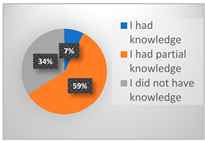 |
| I had partial knowledge | 58.46% | ||
| I did not have knowledge | 34.12% | ||
| 2. Have you ever worked on or participated in any project where Value Management (VM), Value Analysis (VA), or Value Engineering (VE) was applied? | Yes | 15.43% |  |
| No | 84.57% | ||
| 3. Do you think that the application of this method in public construction tenders is necessary? | Yes | 75.07% | 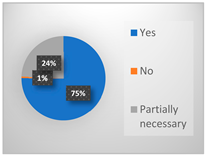 |
| No | 0.59% | ||
| Partially necessary | 24.33% | ||
| 4. If Value Management (VM) is implemented in public construction tenders in our country, who do you believe should cover the expenses of the VM team? | Public institution | 16.62% | 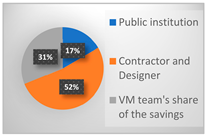 |
| Contractor and Designer | 52.23% | ||
| VM team’s share of the savings | 31.16% | ||
| 5. If Value Management (VM) is implemented in public construction tenders, what are your thoughts on including the cost savings achieved through VM at the tender proposal stage within the tender legislation? | I find it necessary | 67.95% | 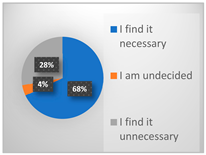 |
| I am undecided | 4.15% | ||
| I find it unnecessary | 27.89% | ||
| 6. If Value Management (VM) is implemented in public construction tenders, at which stage of the project do you think its application would be most beneficial? | At the proposal phase | 23.44% |  |
| At the construction phase | 10.68% | ||
| At both phases | 64.69% | ||
| Other | 1.19% | ||
| 7. If Value Management (VM) is implemented in public construction tenders, which method do you believe is more applicable given the implementation costs and associated risks? | At the proposal phase | 23.44% | 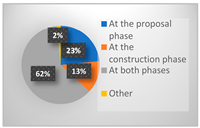 |
| At the construction phase | 13.35% | ||
| At both phases | 61.72% | ||
| Other | 1.49% | ||
| 8. If Value Management (VM) is implemented in public construction tenders, what are your thoughts on considering benefits such as cost reduction and more efficient use of time, alongside the social benefits of the project areas where VM is applied? | I find it necessary | 69.73% |  |
| I am undecided | 1.78% | ||
| I find it unnecessary | 28.49% | ||
| 9. Were you aware that the European Union standards concerning the Value Management (VM) methodology have been harmonized and published by TSE? | Yes, I was aware. | 6.82% |  |
| I was somewhat aware. | 73.00% | ||
| No, I was not aware. | 20.18% | ||
| 10. How do you believe the inclusion of VM in public tenders should be legislated? | It should be mandatory for all tenders. | 48.07% | 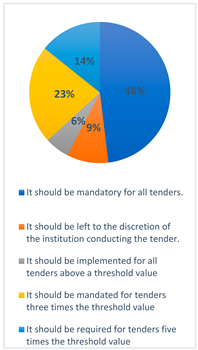 |
| It should be left to the discretion of the institution conducting the tender. | 9.50% | ||
| It should be implemented for all tenders above a threshold value | 5.64% | ||
| It should be mandated for tenders three times the threshold value | 22.55% | ||
| It should be required for tenders five times the threshold value | 14.24% | ||
| 11. In the legislation concerning the implementation of VM in public tenders, how do you think cost savings should be shared between the administration and the contracting company? | Shared equally between the administration and the contractor | 47.18% |  |
| Allocated entirely to the contractor | 16.32% | ||
| Retained completely by the administration | 25.52% | ||
| Left to the discretion of the institution conducting the tender | 10.98% | ||
| 12. If the implementation of VM is made mandatory in public tenders, what do you think the transition process should entail? | Immediate implementation | 47.48% |  |
| Announcement of an effective date | 14.54% | ||
| Left to the discretion of the institutions conducting the tender | 9.20% | ||
| Conducting a pilot application in designated institutions | 28.78% | ||
| 13. Did you have any information about the Value for Europe training and certification umbrella organization before this survey? | I had information | 2.97% | 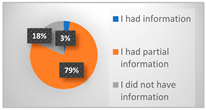 |
| I had partial information | 78.64% | ||
| I did not have information | 18.40% | ||
| 14. If Value for Europe is implemented in public tenders, would you consider becoming a member of the National Value Management Association/Organization that will be established for training and certification? | Yes, I would | 48.96% | 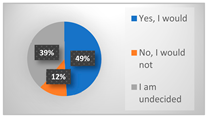 |
| No, I would not | 12.17% | ||
| I am undecided | 38.87% | ||
| 15. Do you think that if Value for Europe is implemented in the Turkish construction sector, the international market share of our contractor companies could increase? | Agree | 73.29% | 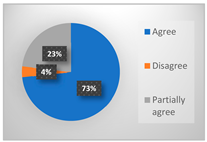 |
| Disagree | 3.56% | ||
| Partially agree | 23.15% |
Disclaimer/Publisher’s Note: The statements, opinions and data contained in all publications are solely those of the individual author(s) and contributor(s) and not of MDPI and/or the editor(s). MDPI and/or the editor(s) disclaim responsibility for any injury to people or property resulting from any ideas, methods, instructions or products referred to in the content. |
© 2025 by the authors. Licensee MDPI, Basel, Switzerland. This article is an open access article distributed under the terms and conditions of the Creative Commons Attribution (CC BY) license (https://creativecommons.org/licenses/by/4.0/).
Share and Cite
Mum, N.; Atabay, Ş.; Tekin, H.; Akkaya, D. Addressing the Value Management Approach in Public Construction Works: Barriers, Critical Success Factors, and Potential Risks. Sustainability 2025, 17, 5247. https://doi.org/10.3390/su17125247
Mum N, Atabay Ş, Tekin H, Akkaya D. Addressing the Value Management Approach in Public Construction Works: Barriers, Critical Success Factors, and Potential Risks. Sustainability. 2025; 17(12):5247. https://doi.org/10.3390/su17125247
Chicago/Turabian StyleMum, Nusret, Şenay Atabay, Hamdi Tekin, and Durmuş Akkaya. 2025. "Addressing the Value Management Approach in Public Construction Works: Barriers, Critical Success Factors, and Potential Risks" Sustainability 17, no. 12: 5247. https://doi.org/10.3390/su17125247
APA StyleMum, N., Atabay, Ş., Tekin, H., & Akkaya, D. (2025). Addressing the Value Management Approach in Public Construction Works: Barriers, Critical Success Factors, and Potential Risks. Sustainability, 17(12), 5247. https://doi.org/10.3390/su17125247






